Mechanical Properties and Damage Evolution of Heated Granite Subjected to Liquid Nitrogen Cooling
Abstract
:1. Introduction
2. Materials and Methods
2.1. Materials Preparation and Experimental Procedure
2.1.1. Materials Preparation
2.1.2. Experimental Procedure
2.2. Statistical Damage Constitutive Model
2.2.1. Damage Variables and Statistical Damage Constitutive Equation
2.2.2. Determination of and
2.3. Calculation of Energy Dissipation Ratio
3. Mechanical Properties of Heated Granite after Different Cooling Treatments
3.1. Stress–Strain Curves
3.2. Uniaxial Compressive Strength
3.3. Deformability in Uniaxial Compression
4. Discussion on Damage Evolution
4.1. Model Validation
4.2. Damage Evolution Analysis
4.2.1. Damage Variable
4.2.2. Damage Evolution Rate
4.2.3. Energy Dissipation Ratio
4.3. Further Discussion on the Current Work
5. Conclusions
- There is an increase in the uniaxial compressive strength of the heated granite before 200 °C, which is due to the competitive relationship between the thermal cracking and crack closure. When the temperature is high enough that the thermal cracking is more prominent, the compressive strength decreases.
- The LN2 cooling can deteriorate the mechanical properties of the heated granite in terms of strength and deformability. This softening effect is improved with the increasing temperature. At 400 °C, the reduction rates of the compressive strength and stiffness between the air cooling and LN2 cooling reached 32.36% and 47.72%, respectively.
- The LN2 cooling induces greater initial thermal damage and, consequently, leads to a greater degree of total damage before the peak stress and makes rock easier to be damaged. The increase in temperature contributes to these deterioration effects. At 400 °C, the total damage at the peak stress increased from 0.179 to 0.587 after the LN2 cooling.
- Through the dissipation energy ratio, which was newly defined, the difficulty of the damage was revealed to characterize the softening effect of LN2. It is proved that granite is more easily damaged after LN2 cooling and a high temperature can promote the degradation of LN2.
Author Contributions
Funding
Conflicts of Interest
References
- Xie, H.; Li, C.; Zhou, T.; Chen, J.; Liao, J.; Ma, J.; Li, B. Conceptualization and evaluation of the exploration and utilization of low/medium-temperature geothermal energy: A case study of the Guangdong-Hong Kong-Macao Greater Bay Area. Geomech. Geophys. Geo-Energy Geo-Resour. 2020, 6, 18. [Google Scholar] [CrossRef]
- Tomac, I.; Sauter, M. A review on challenges in the assessment of geomechanical rock performance for deep geothermal reservoir development. Renew. Sustain. Energy Rev. 2018, 82, 3972–3980. [Google Scholar] [CrossRef]
- Grundmann, S.; Rodvelt, G.; Dials, G.; Allen, R. Cryogenic nitrogen as a hydraulic fracturing fluid in the Devonian Shale. In Proceedings of the SPE Eastern Regional Conference and Exhibition, Pittsburgh, PA, USA, 9–11 November 1998. [Google Scholar]
- Mcdaniel, B.W.; Grundmann, S.; Kendrick, W.; Wilson, D.; Jordan, S. Field applications of cryogenic nitrogen as a hydraulic fracturing fluid. In Proceedings of the SPE Annual Technical Conference and Exhibition, San Antonio, TX, USA, 5–8 October 1997. [Google Scholar]
- Yang, R.; Hong, C.; Liu, W.; Wu, X.; Wang, T.; Huang, Z. Non-contaminating cryogenic fluid access to high-temperature resources: Liquid nitrogen fracturing in a lab-scale Enhanced Geothermal System. Renew. Energy 2021, 165, 125–138. [Google Scholar] [CrossRef]
- Zhang, S.; Huang, Z.; Zhang, H.; Guo, Z.; Wu, X.; Wang, T.; Zhang, C.; Xiong, C. Experimental study of thermal-crack characteristics on hot dry rock impacted by liquid nitrogen jet. Geothermics 2018, 76, 253–260. [Google Scholar] [CrossRef]
- Su, S.; Hou, P.; Gao, F.; Liang, X.; Ding, R.; Cai, C. Changes in mechanical properties and fracture behaviors of heated marble subjected to liquid nitrogen cooling. Eng. Fract. Mech. 2022, 261, 108256. [Google Scholar] [CrossRef]
- Zhou, C.; Gao, F.; Cai, C.; Wang, Z.; Zheng, W.; Gao, X. Integrating acoustic emission into a percolation model to evaluate crack distribution characteristics of heated granite subjected to rapid cooling. Results Phys. 2022, 38, 105600. [Google Scholar] [CrossRef]
- Hou, P.; Xue, Y.; Gao, F.; Dou, F.; Su, S.; Cai, C.; Zhu, C. Effect of liquid nitrogen cooling on mechanical characteristics and fracture morphology of layer coal under Brazilian splitting test. Int. J. Rock Mech. Min. 2022, 151, 105026. [Google Scholar] [CrossRef]
- Hou, P.; Chen, G.; Su, S.; Yang, Y.; Cai, C.; Wang, S.; Qiu, J.; Gao, F. Influence of various control factors on fracture toughness and fracture energy of sandstone subjected to liquid nitrogen cooling. Energy Fuel. 2022, 36, 397–406. [Google Scholar] [CrossRef]
- Wu, X.; Huang, Z.; Zhang, S.; Cheng, Z.; Li, R.; Song, H.; Wen, H.; Huang, P. Damage analysis of high-temperature rocks subjected to LN2 thermal shock. Rock Mech. Rock Eng. 2019, 52, 2585–2603. [Google Scholar] [CrossRef]
- Kang, F.; Li, Y.; Tang, C. Grain size heterogeneity controls strengthening to weakening of granite over high-temperature treatment. Int. J. Rock Mech. Min. 2021, 145, 104848. [Google Scholar] [CrossRef]
- Gautam, P.K.; Jha, M.K.; Verma, A.K.; Singh, T.N. Experimental study of thermal damage under compression and tension of Makrana marble. J. Therm. Anal. Calorim. 2020, 139, 609–627. [Google Scholar] [CrossRef]
- Wang, F.; Frühwirt, T.; Konietzky, H. Influence of repeated heating on physical-mechanical properties and damage evolution of granite. Int. J. Rock Mech. Min. 2020, 136, 104514. [Google Scholar] [CrossRef]
- Hou, P.; Su, S.; Zhang, Y.; Gao, F.; Gao, Y.; Liang, X.; Ding, R.; Cai, C. Effect of liquid nitrogen thermal shock on structure damage and brittleness properties of high-temperature marble. Geomech. Geophys. Geo-Energy Geo-Resour. 2022, 8, 69. [Google Scholar] [CrossRef]
- Kang, F.; Jia, T.; Li, Y.; Deng, J.; Tang, C.; Huang, X. Experimental study on the physical and mechanical variations of hot granite under different cooling treatments. Renew. Energy 2021, 179, 1316–1328. [Google Scholar] [CrossRef]
- Sha, S.; Rong, G.; Chen, Z.; Li, B.; Zhang, Z. Experimental evaluation of physical and mechanical properties of geothermal reservoir rock after different cooling treatments. Rock Mech. Rock Eng. 2020, 53, 4967–4991. [Google Scholar] [CrossRef]
- Shao, Z.; Wang, Y.; Tang, X. The influences of heating and uniaxial loading on granite subjected to liquid nitrogen cooling. Eng. Geol. 2020, 271, 105614. [Google Scholar] [CrossRef]
- Ge, Z.; Sun, Q.; Yang, T.; Luo, T.; Jia, H.; Yang, D. Effect of high temperature on mode-I fracture toughness of granite subjected to liquid nitrogen cooling. Eng. Fract. Mech. 2021, 252, 107834. [Google Scholar] [CrossRef]
- Wu, X.; Huang, Z.; Song, H.; Zhang, S.; Cheng, Z.; Li, R.; Wen, H.; Huang, P.; Dai, X. Variations of physical and mechanical properties of heated granite after rapid cooling with liquid nitrogen. Rock Mech. Rock Eng. 2019, 52, 2123–2139. [Google Scholar] [CrossRef]
- Zhou, C.; Gao, F.; Cai, C.; Su, S.; Zheng, W.; Huo, L. Variations in stress thresholds for heated granite subjected to rapid cooling under different confining pressures. Nat. Resour. Res. 2022, 31, 2653–2671. [Google Scholar] [CrossRef]
- Wu, X.; Huang, Z.; Li, R.; Zhang, S.; Wen, H.; Huang, P.; Dai, X.; Zhang, C. Investigation on the damage of high-temperature shale subjected to liquid nitrogen cooling. J. Nat. Gas Sci. Eng. 2018, 57, 284–294. [Google Scholar] [CrossRef]
- Sun, Y.; Zhai, C.; Xu, J.; Yu, X.; Cong, Y.; Zheng, Y.; Tang, W.; Li, Y. Damage and failure of hot dry rock under cyclic liquid nitrogen cold shock treatment: A non-destructive ultrasonic test method. Nat. Resour. Res. 2022, 31, 261–279. [Google Scholar] [CrossRef]
- Rong, G.; Sha, S.; Li, B.; Chen, Z.; Zhang, Z. Experimental investigation on physical and mechanical properties of granite subjected to cyclic heating and liquid nitrogen cooling. Rock Mech. Rock Eng. 2021, 54, 2383–2403. [Google Scholar] [CrossRef]
- Li, Q.; Yin, T.; Li, X.; Zhang, S. Effects of rapid cooling treatment on heated sandstone: A comparison between water and liquid nitrogen cooling. Bull. Eng. Geol. Environ. 2020, 79, 313–327. [Google Scholar] [CrossRef]
- Cevik, A.; Sezer, E.A.; Cabalar, A.F.; Gokceoglu, C. Modeling of the uniaxial compressive strength of some clay-bearing rocks using neural network. Appl. Soft Comput. 2011, 11, 2587–2594. [Google Scholar] [CrossRef]
- Tang, S.B.; Tang, C.A. Crack propagation and coalescence in quasi-brittle materials at high temperatures. Eng. Fract. Mech. 2015, 134, 404–432. [Google Scholar] [CrossRef]
- Zhou, S.; Xia, C.; Zhao, H.; Mei, S.; Zhou, Y. Statistical damage constitutive model for rocks subjected to cyclic stress and cyclic temperature. Acta Geophys. 2017, 65, 893–906. [Google Scholar] [CrossRef]
- Chen, Y.; Lin, H.; Wang, Y.; Xie, S.; Zhao, Y.; Yong, W. Statistical damage constitutive model based on the Hoek–Brown criterion. Arch. Civ. Mech. Eng. 2021, 21, 117. [Google Scholar] [CrossRef]
- Rong, T.; Guan, C.; Liu, K.; Heng, S.; Shen, W.; Mou, R. A statistical damage constitutive model of anisotropic rock: Development and validation. Geofluids 2021, 2021, 6307895. [Google Scholar] [CrossRef]
- Krajcinovic, D.; Silva, M.A.G. Statistical aspects of the continuous damage theory. Int. J. Solids Struct. 1982, 18, 551–562. [Google Scholar] [CrossRef]
- Huang, S.; Liu, Q.; Cheng, A.; Liu, Y. A statistical damage constitutive model under freeze-thaw and loading for rock and its engineering application. Cold Reg. Sci. Technol. 2018, 145, 142–150. [Google Scholar] [CrossRef]
- Fang, W.; Jiang, N.; Luo, X. Establishment of damage statistical constitutive model of loaded rock and method for determining its parameters under freeze-thaw condition. Cold Reg. Sci. Technol. 2019, 160, 31–38. [Google Scholar] [CrossRef]
- Pan, Y.; Zhao, Z.; He, L.; Wu, G. A nonlinear statistical damage constitutive model for porous rocks. Adv. Civ. Eng. 2020, 2020, 8851914. [Google Scholar] [CrossRef]
- Bieniawski, Z.T.; Bernede, M.J. Suggested methods for determining the uniaxial compressive strength and deformability of rock materials. Int. J. Rock Mech. Min. Sci. Geomech. Abstr. 1979, 16, 137–140. [Google Scholar] [CrossRef]
- Kumari, W.G.P.; Ranjith, P.G.; Perera, M.S.A.; Chen, B.K.; Abdulagatov, I.M. Temperature-dependent mechanical behaviour of Australian Strathbogie granite with different cooling treatments. Eng. Geol. 2017, 229, 31–44. [Google Scholar] [CrossRef]
- Chen, Y.; Xiao, P.; Du, X.; Wang, S.; Wang, Z.; Azzam, R. Study on damage statistical constitutive model of triaxial compression of acid-etched rock under coupling effect of temperature and confining Pressure. Materials 2021, 14, 7414. [Google Scholar] [CrossRef] [PubMed]
- Lemaitre, J. How to use damage mechanics. Nucl. Eng. Des. 1984, 80, 233–245. [Google Scholar] [CrossRef]
- Xie, H.; Li, C.; He, Z.; Li, C.; Lu, Y.; Zhang, R.; Gao, M.; Gao, F. Experimental study on rock mechanical behavior retaining the in situ geological conditions at different depths. Int. J. Rock Mech. Min. 2021, 138, 104548. [Google Scholar] [CrossRef]
- Kumari, W.G.P.; Beaumont, D.M.; Ranjith, P.G.; Perera, M.S.A.; Avanthi Isaka, B.L.; Khandelwal, M. An experimental study on tensile characteristics of granite rocks exposed to different high-temperature treatments. Geomech. Geophys. Geo-Energy Geo-Resour. 2019, 5, 47–64. [Google Scholar] [CrossRef]
- Wang, S.; Liao, H.; Chen, Y.; Fernández-Steeger, T.M.; Du, X.; Xiong, M.; Liao, S. Damage evolution constitutive behavior of rock in thermo-mechanical coupling processes. Materials 2021, 14, 7840. [Google Scholar] [CrossRef] [PubMed]
- Kurtoğlu, A.E.; Anil, Ö.; Çevik, A. A machine-learning-based constitutive bond-slip model for anchored CFRP strips externally bonded on concrete members. Struct. Concr. 2022, 23, 1828–1844. [Google Scholar] [CrossRef]
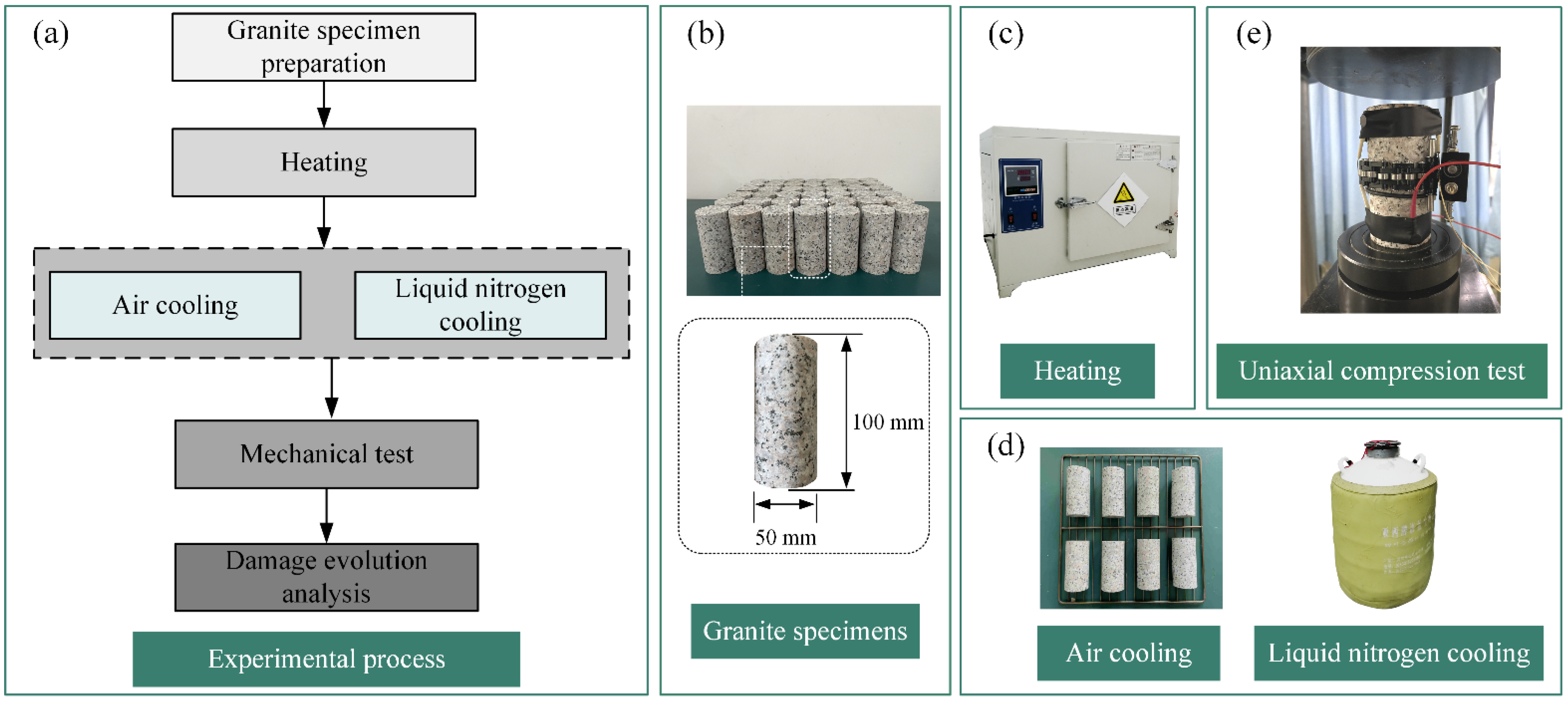

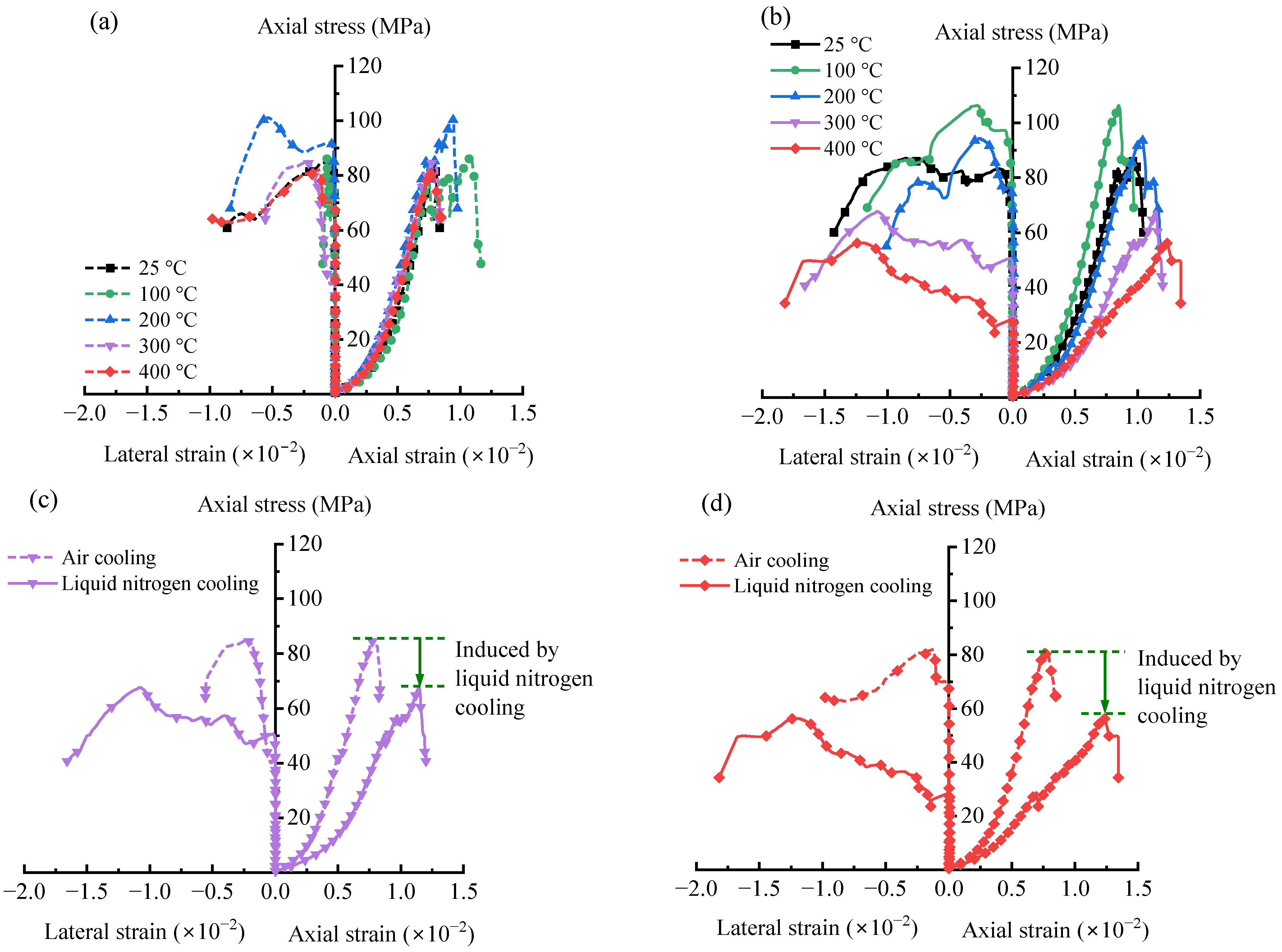
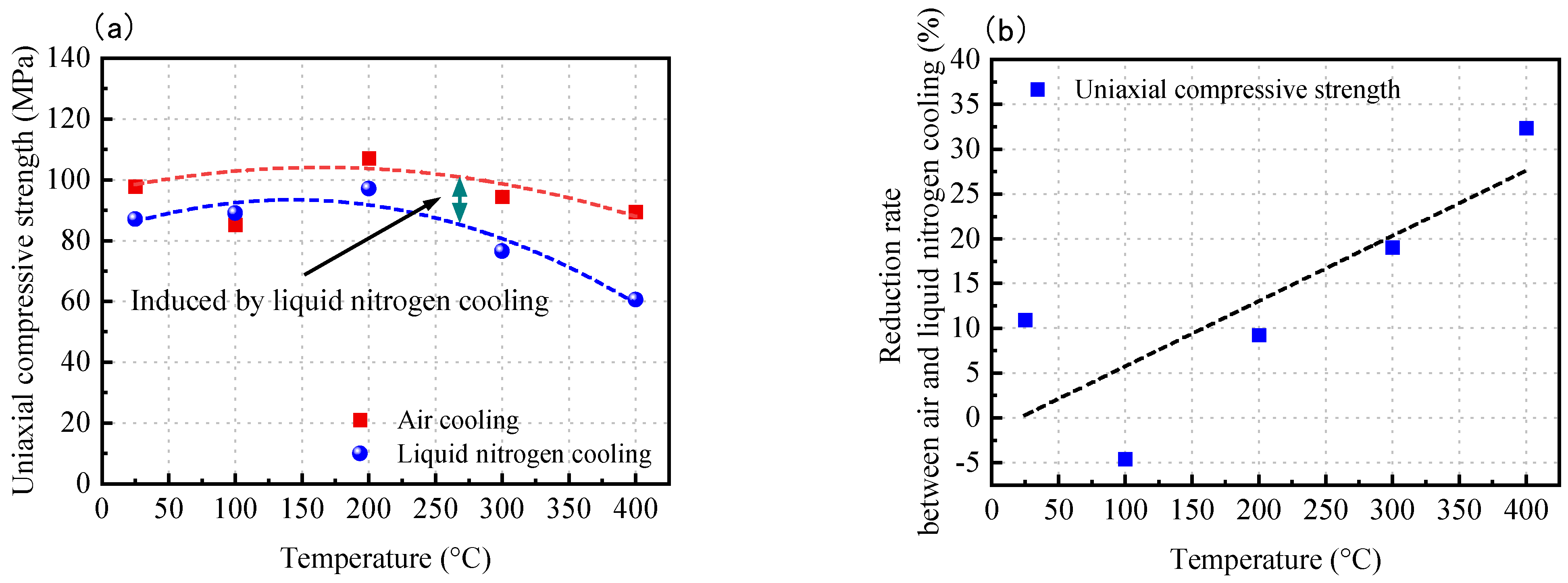
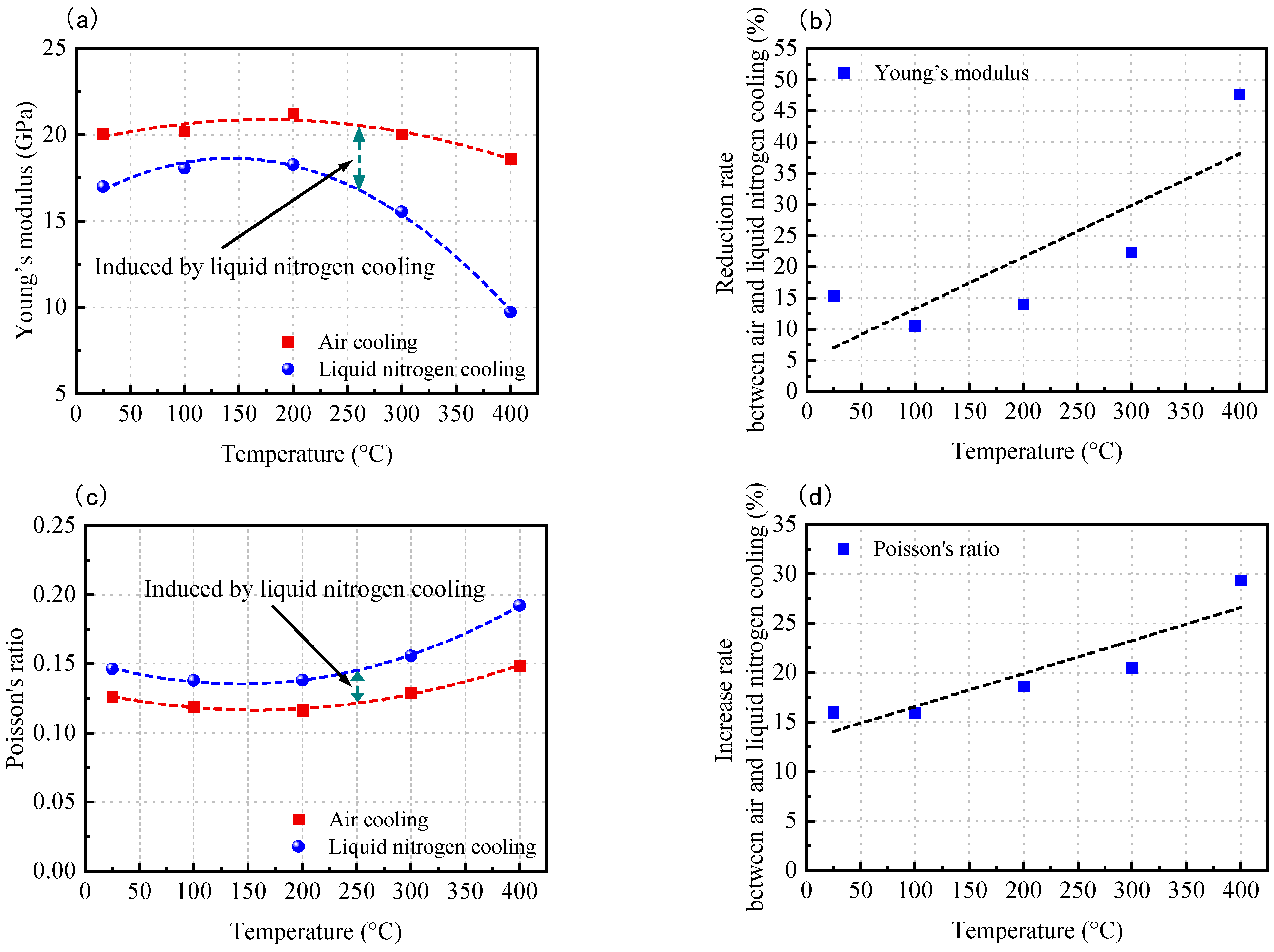

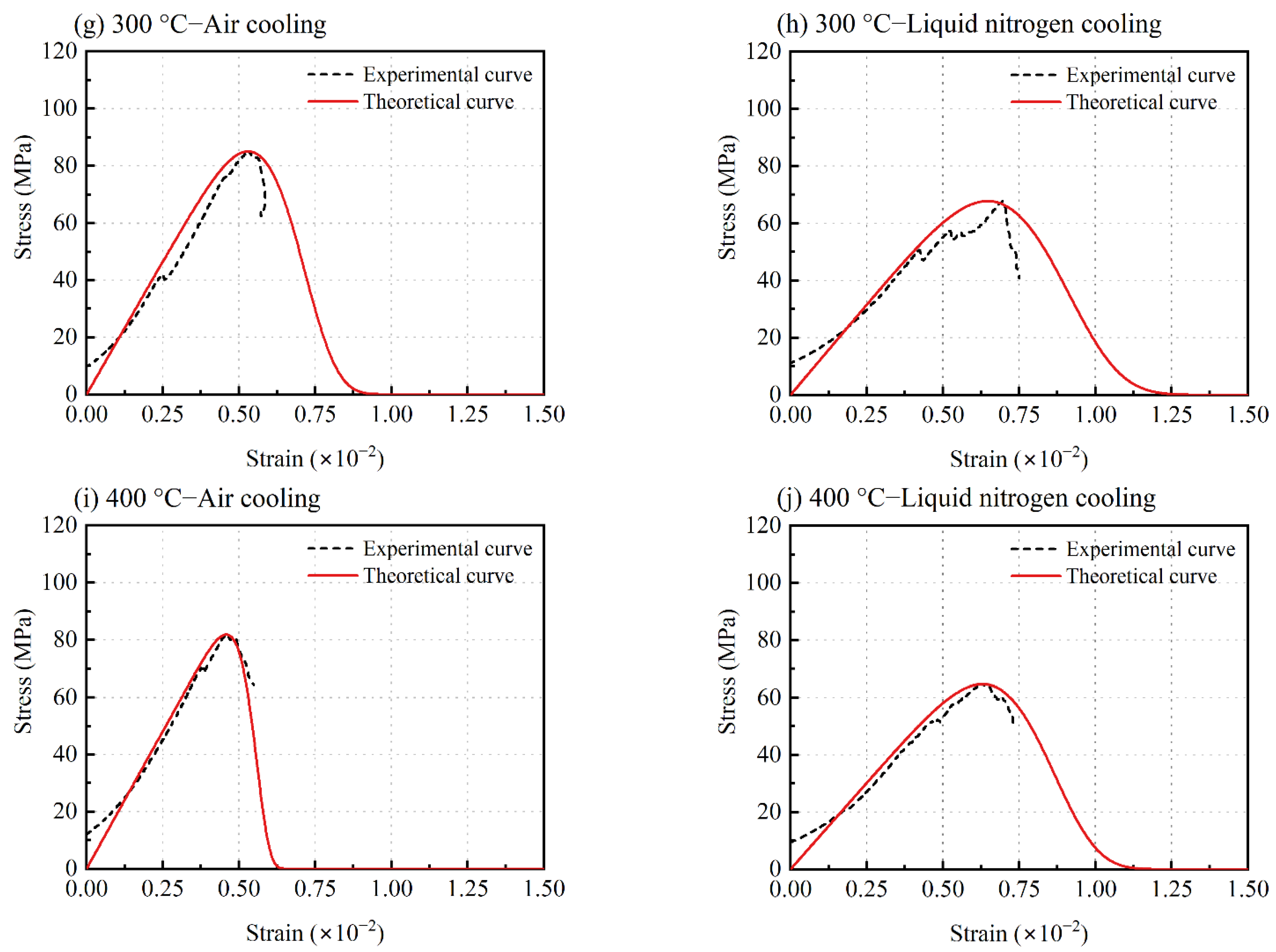
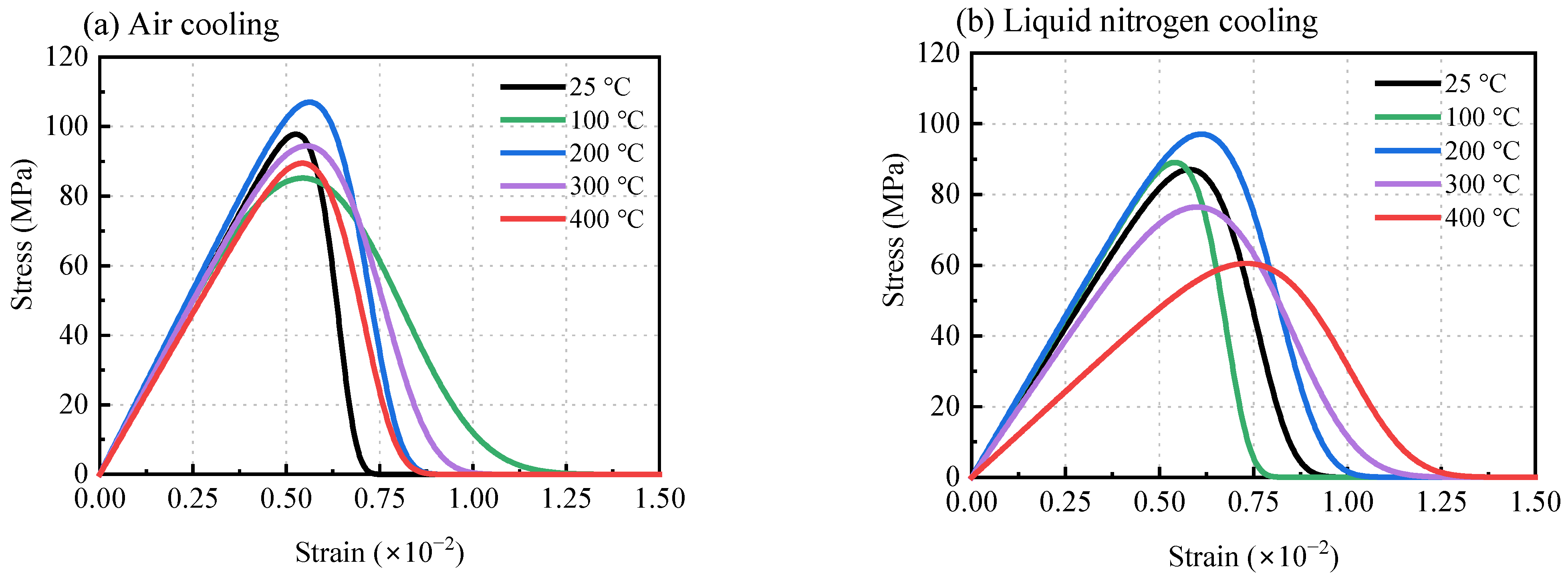

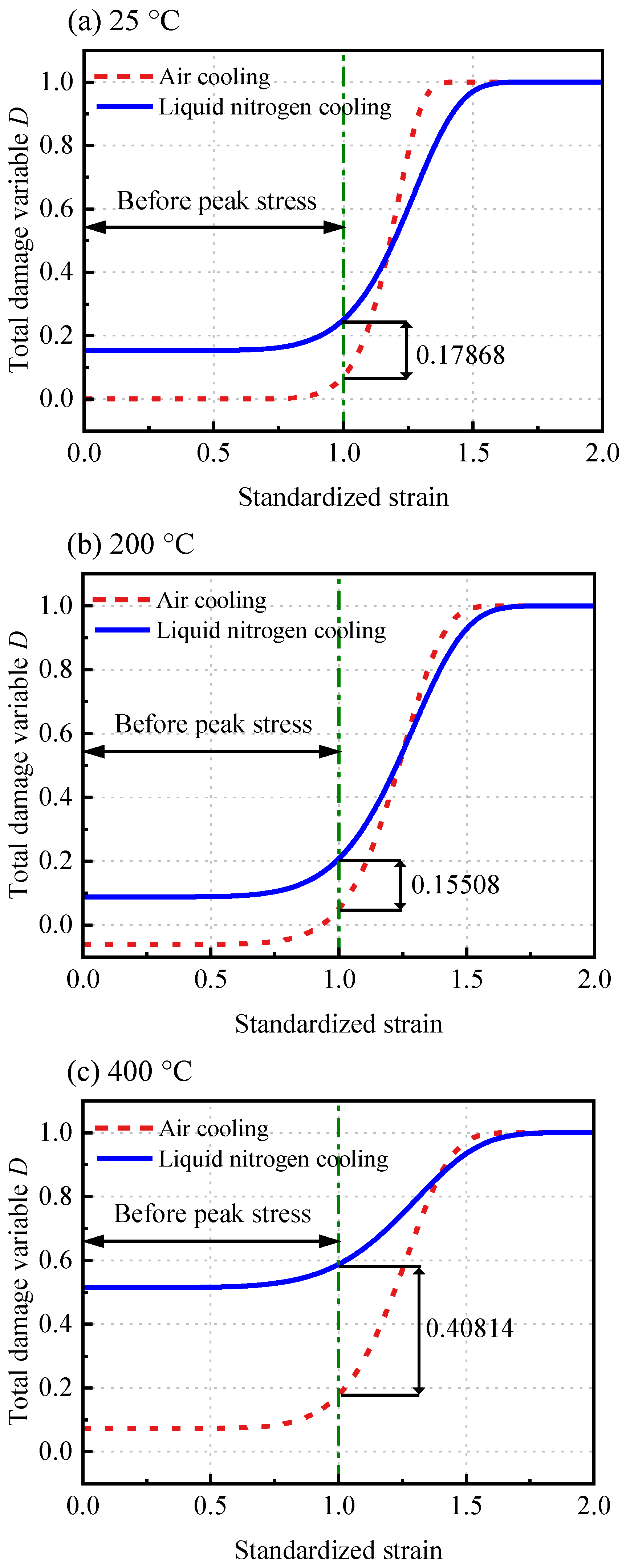
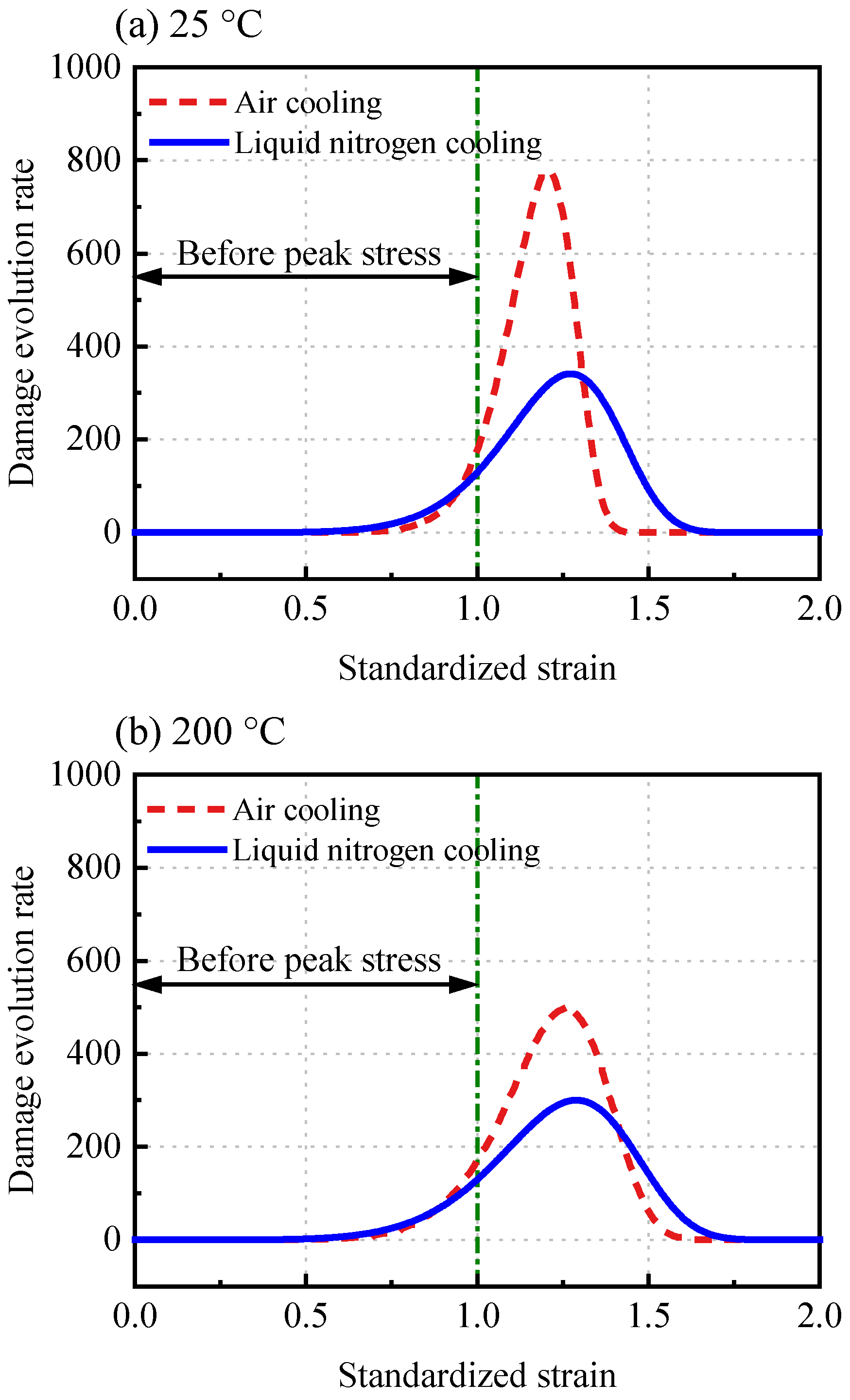
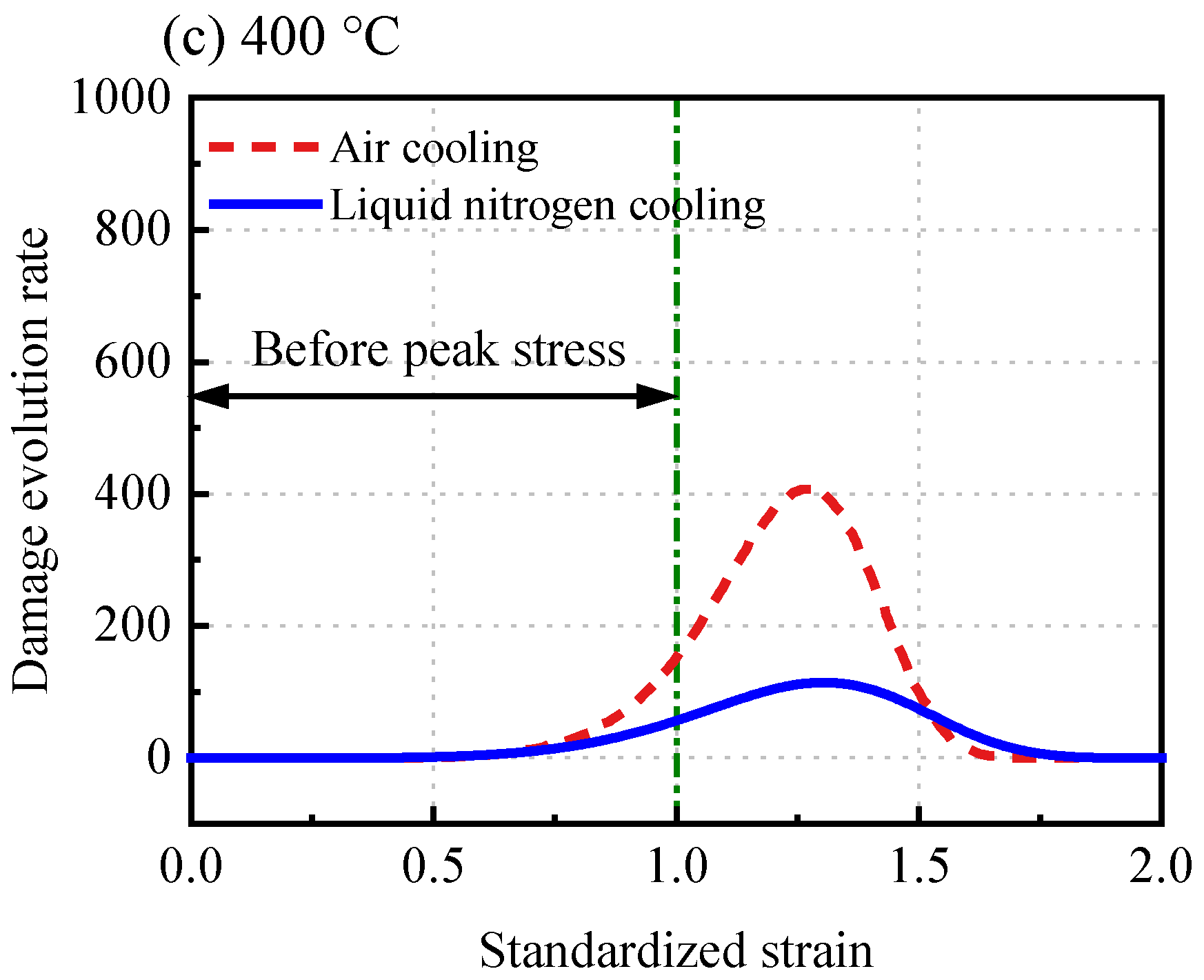
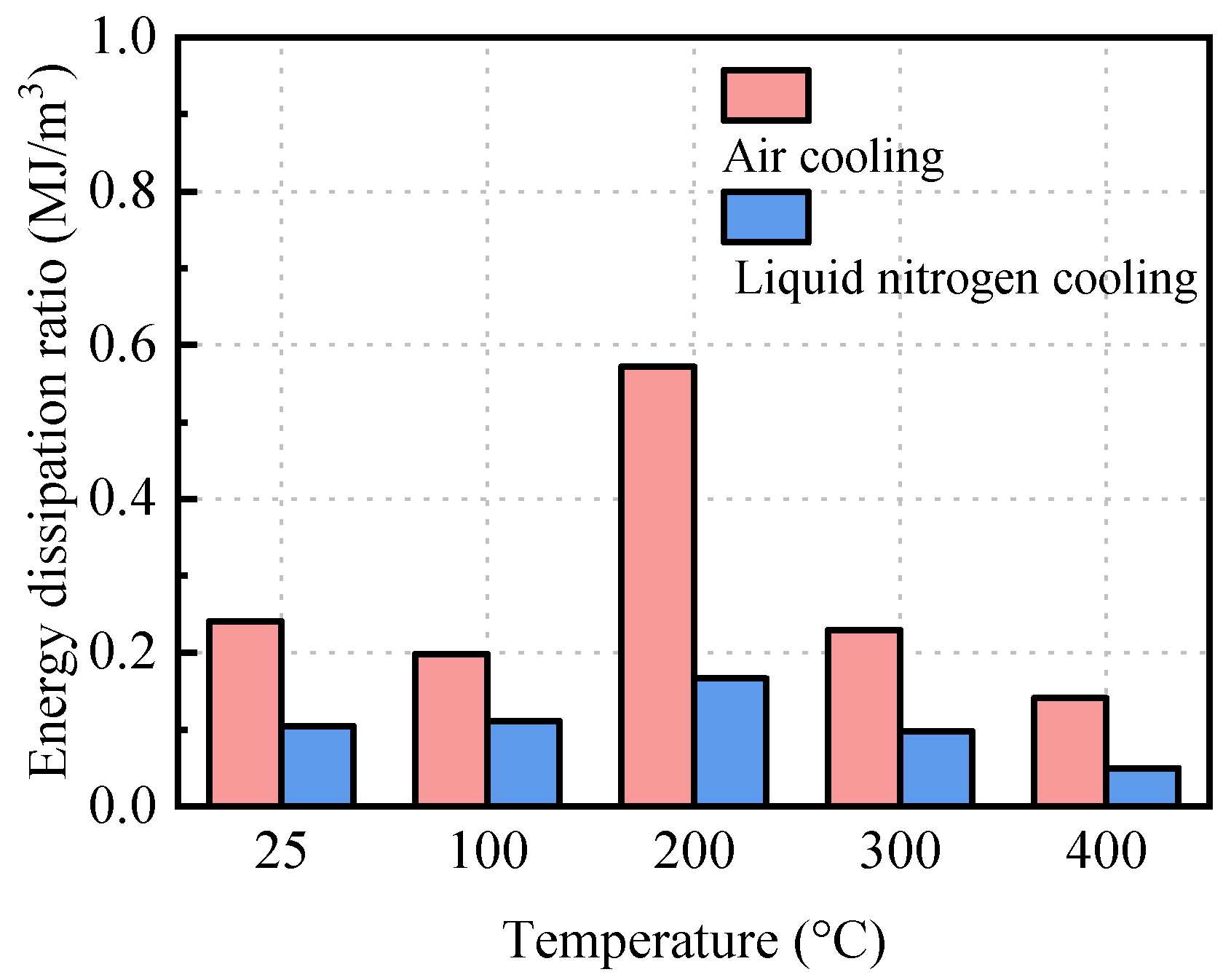
Publisher’s Note: MDPI stays neutral with regard to jurisdictional claims in published maps and institutional affiliations. |
© 2022 by the authors. Licensee MDPI, Basel, Switzerland. This article is an open access article distributed under the terms and conditions of the Creative Commons Attribution (CC BY) license (https://creativecommons.org/licenses/by/4.0/).
Share and Cite
Zhou, C.; Gao, F.; Cai, C.; Zheng, W.; Huo, L. Mechanical Properties and Damage Evolution of Heated Granite Subjected to Liquid Nitrogen Cooling. Appl. Sci. 2022, 12, 10615. https://doi.org/10.3390/app122010615
Zhou C, Gao F, Cai C, Zheng W, Huo L. Mechanical Properties and Damage Evolution of Heated Granite Subjected to Liquid Nitrogen Cooling. Applied Sciences. 2022; 12(20):10615. https://doi.org/10.3390/app122010615
Chicago/Turabian StyleZhou, Chunbo, Feng Gao, Chengzheng Cai, Wenqi Zheng, and Liupeng Huo. 2022. "Mechanical Properties and Damage Evolution of Heated Granite Subjected to Liquid Nitrogen Cooling" Applied Sciences 12, no. 20: 10615. https://doi.org/10.3390/app122010615
APA StyleZhou, C., Gao, F., Cai, C., Zheng, W., & Huo, L. (2022). Mechanical Properties and Damage Evolution of Heated Granite Subjected to Liquid Nitrogen Cooling. Applied Sciences, 12(20), 10615. https://doi.org/10.3390/app122010615





